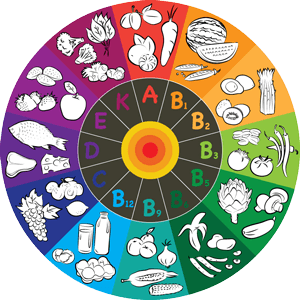 Vitamins, minerals and enzymes are the genuine parts necessary to develop, maintain and fix every organ and every function in our body. But these vitamins, minerals and enzymes must be delivered in a form that the bodies can use.
Vitamins, minerals and enzymes are the genuine parts necessary to develop, maintain and fix every organ and every function in our body. But these vitamins, minerals and enzymes must be delivered in a form that the bodies can use.
The only source of nutrition in the world is food. Everything else is an interference in our internal function and just like pharmaceutical drugs, must be balanced with side effects in order for our bodies to do what they must do; maintain homeostasis to keep us alive.
Vitamins are complex combinations of co-factors, which include many different components and enzymes. The true nature of this synergy has yet to be truly understood, let alone replicated by a laboratory.
Every type of whole food and its substrates are made up of complex organisms that cannot be replicated in the form of an isolated chemical. When we eat an orange, for example, there are dozens of vital components that make up its nutrients in the form of Vitamin C and A complex and other essential nutrients. Vitamin A Complex alone has over 64 components responsible for it’s absorption and utilization, including co-factors of minerals and enzymes.
When we take vitamins in the form of chemical isolated synthetics, we are taking only 1 of these complex components. So what does our body do? It does what it is designed to do…survives by establishing homeostasis. And to do that, it looks for the other components required to absorb and utilize the nutrient. When it does not find this in our digestive system, it pulls what it can from our own body and eliminates the rest as toxins. This is the reason many people urinate bright yellow upon ingesting synthetic vitamins.
This causes a long-term deficiency in the very vitamin we are trying to supplement. Please understand that, like a drug, we get a short-term therapeutic effect, which can go on for sometime. But over the long term, we are running out of gas.
And this is especially true for so called vitamins as anti-oxidants. Anti-oxidants were branded in the late 50’s and early 60’s after experiments on laboratory animals (rats and guinea pigs) showed positive effects for certain diseases. The problem was that these were never methodically tested on human beings and therefore we made a leap to assume that the same chemical compound that serves as a vitamin for one species would serve for humans.
But we know that every species has its own dietary requirements that cannot be easily used by another. How long would people live if they had to survive on the diet of a rat, or guinea pig? Yet we are taking anti-oxidants based on lab results for these animals. Even pharmaceutical drugs are eventually tested on people to certify their safety and efficacy.
So it’s not that surprising that when these so called vitamins were finally tested on humans in large mega-studies costing billions of dollars, the results were negative. In the largest study ever on the efficacy of antioxidants, published in the Journal of the American Medical Association in 2007, it was found that taking these so called vitamins for long periods of time were associated with all cause mortality. That means people died from all forms of death more when consuming antioxidants than when not. And in the case of certain diseases like melanoma the deadliest form of skin cancer), women were 400% more likely to get it. And people had more heart attacks, strokes and cancers as well.
Oxidation is what causes fruit to go bad when it hits the air. So nature has developed protection of nutrients in plants and fruits that must survive in an atmosphere of over 22% oxygen. And these anti-oxidants (Ascorbic acid, Beta-carotene, Tocopherols) are the protection (like preservatives). But why would the protection of the nutrients be the nutrients themselves any more than a bank guard would be there to protect the bank guard?
Our bodies do not oxidize from oxygen. We need oxygen more than any other nutrient. How long can we live without oxygen compared to any nutrient? So taking chemicals that stop oxygen from working is against the foundation of survival of animals and humans.
But, like so many times in the past, financial interests survived by creating a justification for the proliferation of its product: ‘Free Radical Pathology’. This was a theory (never proven) that was based on the idea that oxygen molecules, in a radical form, are floating around the body harming and eroding tissues.
But this does not make sense if we think about physiological pathways in the body. When we breathe, oxygen is exchanged for carbon dioxide in the alveoli of the lungs and carried in the blood by hemoglobin molecules. At the capillary level, tissues are provided with oxygen to fuel cell production. As a result of this production (called the Krebs Cycle) carbon dioxide is given off as a by-product and carried to the lungs by the venus return system.
Free radical oxygen molecules, if there are any, are easily handled by the enzyme superoxide dismutase and other enzymes in every cell of our body. Free radical oxygen is made by our body inside certain cells to kill germs, unwanted viruses and other intruders. Disease is not the result of oxidation like an apple or banana. It is the result of loss of function due to long-term nutritional deficiency. And taking anti-oxidants only accelerates this process by robbing the body of the very thing it needs most: Oxygen.
Do we need supplementation? Yes. But this supplementation must be in a form our bodies can use: food.
